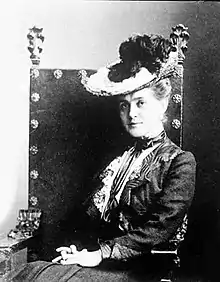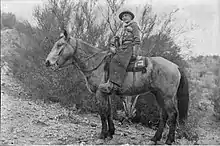Agnes Sorma
Agnes Sorma (c. 1862 – 10 February 1927), born Agnes Maria Caroline Zaremba, was a German actress. Some sources give 1865 as her year of birth.
Agnes Sorma | |
|---|---|
 | |
| Born | c. 1862 |
| Died | 10 February 1927 (aged 64) |
| Other names | Agnes Zaremba, Agnes Minotto |
| Occupation | Actress |
Early life
Agnes Maria Caroline Zaremba was born in Breslau, Province of Silesia, Prussia (now Wrocław, Poland).[1] A street in Breslau was once named Agnes-Sorma-Straße in her honour, but when the city was transferred to Poland after World War II, the street was renamed to Ulica Heleny Modrzejewskiej after Sorma's near-contemporary, the Polish actress Helena Modjeska.
Career
In 1884, having performed in regional theatres, Sorma was invited to join the Deutsches Theater in Berlin, as a character actress. Sorma was perhaps best known for playing Nora in Henrik Ibsen's A Doll's House, beginning in 1894.[2] She played Nora in Paris in 1899, where a critic marveled at her interpretation of the character: "Sorma has no need to resort to the tricks and devices of the art of acting; she had but to live and to reproduce that nature which she had assimilated to her own personality," concluding that "a great performance like hers dissolves all criticism into praise, and the highest tribute of all is speechless admiration."[3] She also played Nora in the United States (1897),[4] Italy, Austria, Belgium, Greece, and the Netherlands, and was the first actress known to play the character in Istanbul.[5]
Other stage appearances by Sorma were roles in The Sunken Bell, Der Strom,[6] Liebelei, The Taming of the Shrew, Diplomacy, Chic, Hero and Leander, Die Konigskinder, Mädchentraum, Cyprienne, and Morituri.[7][8][9] Many of her performances in New York and Chicago were given in German, for German-speaking American audiences.[10][11]

_Agnes_Sorma_Gr%C3%A4fin_Mionotto.jpg.webp)
Personal life
Agnes Sorma married an Italian count and diplomat, Demetrius Minotto, in 1890. They had a son, James Minotto (1891–1980). In 1903, she was hospitalized with "a severe nervous malady", attributed to marital difficulties,[12] after rumors of his gambling debts and her affair with actor Harry Walden.[13][14]
During World War I, she volunteered as a nurse and gave benefit appearances for war relief causes, but was barred from the stage in Hanau because she was an Italian citizen by marriage.[15] Meanwhile, her son in the United States was considered a security threat because of his German birth, and held in an internment camp in Georgia, until his wealthy American in-laws, the Swift family of Chicago, argued for his release.[16][17]
She was widowed in 1920, and she moved to the United States to be near her son, who had a ranch in Arizona, the Z Triangle. She sold her collection of art and antiques in 1925, to fund her travels.[18] She was injured in a fall from a horse in 1926, and she died in Crown King, Arizona, in 1927, aged 63 years, from heart failure.[19][20] Her grave is in Berlin.[21][22]


Sorma's grandson, James Minotto, Jr (1946- ) lives in Phoenix, Arizona and her granddaughter, Anina Minotto (1950 - ), lives in Altadena, California. She had two other grandchildren, Idamay 'Sissi' Minotto Walker (1920-1996), buried in Skull Valley, Arizona and Demetrius "Mitri' Minotto (1917-1968), buried in Phoenix, Arizona. Sorma's great-granddaughters, Laurel Walker Denton and Carol Walker Belmore, live in Skull Valley, Arizona. Laurel Denton is a professional horsewoman and rancher and has served as president of the Arizona Quarter Horse Association and editor of that organization's magazine.[23][24] Sorma has six other great-grandchildren. Tosca Minotto, Lara Minotto, James B Minotto, Andrea Blake Minotto, Prescott Gadd and Ariana Gadd.
Notes
- Painting owned by James Minotto, Jr
- Originally on a granite boulder marking her grave, it was stolen and eventually recovered by James Minotto, Jr
- Photographer unknown. Photo is part of the James Minotto, Jr collection
References
- "Agnes Sorma". Lincoln Journal Star. 10 May 1897. p. 7. Retrieved 10 August 2019 – via Newspapers.com.
- J, Marker Frederick; Marker, Frederick J.; Marker, Lise-Lone; Lise-Lone, Marker (30 March 1989). Ibsen's Lively Art: A Performance Study of the Major Plays. Cambridge University Press. p. 58. ISBN 978-0-521-26643-7.
- Grein, James Thomas (1900). Premières of the Year. J. MacQueen. pp. 128–131, quotes from 130, 131.
- "The Drama: Frau Agnes Sorma". The Critic. 17 April 1897. p. 27 – via ProQuest.
- Holledge, Julie; Bollen, Jonathan; Helland, Frode; Tompkins, Joanne (15 September 2016). A Global Doll's House: Ibsen and Distant Visions. Springer. pp. 35, 42. ISBN 978-1-137-43899-7.
- "Max Halbe's New Play: "Der Strom" Successfully Presented in Berlin – Agnes Sorma's Impressive Acting". The New York Times. 3 January 1904. p. 7 – via ProQuest.
- "Agnes Sorma". The New York Times. 11 September 1927. p. X2 – via ProQuest.
- "Agnes Sorma's Engagement". The New York Times. 26 November 1898. p. 7 – via ProQuest.
- "M'Vicker's". The Inter Ocean. 3 April 1898. p. 39. Retrieved 10 August 2019 – via Newspapers.com.
- "Konigssohn und Gansemagd: Agnes Sorma and Rudolf Christians in "Die Konigskinder" at the Irving Place Theatre". The New York Times. 30 April 1898. p. 6 – via ProQuest.
- ""DIE VERSUNKENE GLOCKE.": Hauptmann's "Marchendrama," with Agnes Sorma as the Enchantress". The New York Times. 30 April 1897. p. 6 – via ProQuest.
- "Sorrows of an Actress". Los Angeles Herald. 8 May 1903. p. 1. Retrieved 10 August 2019 – via California Digital Newspaper Collection.
- "Theatrical Scandal Makes Big Profits". The Sandusky Star-Journal. 20 October 1903. p. 1. Retrieved 10 August 2019 – via Newspapers.com.
- "A Great Actress in Disgrace". The Lincoln Star. 10 September 1903. p. 1. Retrieved 10 August 2019 – via Newspapers.com.
- "Actress' Marriage Bars Appearance". Lansing State Journal. 17 March 1916. p. 6. Retrieved 10 August 2019 – via Newspapers.com.
- "Mrs. Swift Calls Count a Tool, but not Guilty". Chicago Tribune. 15 May 1918. p. 9. Retrieved 10 August 2019 – via Newspapers.com.
- "Count Minotto Not Hun Agent". Salt Lake Telegram. 29 October 1918. p. 10. Retrieved 10 August 2019 – via Newspapers.com.
- "COUNTESS MINOTTO TO SELL COLLECTION: The Former Agnes Sorma to Dispose of Antiques in Order That She May Travel". The New York Times. 29 March 1925. p. E4 – via ProQuest.
- "Countess Agnes Minotto". American Pioneer and Cemetery Research Project. Retrieved 10 August 2019.
- "COUNTESS AGNES MINOTTO.: Former Noted Actress Dies at Her Home in Crown King, Arizona". The New York Times. 12 February 1927. p. 15 – via ProQuest.
- "To Bury Agnes Sorma in Germany". The New York Times. 2 June 1927. p. 29 – via ProQuest.
- "Agnes Sorma Buried". The New York Times. 8 September 1927. p. 27 – via ProQuest.
- "History of The Bar U Bar". Retrieved 10 August 2019.
- "Laurel Denton". Kimes Ranch. Archived from the original on 10 August 2019. Retrieved 10 August 2019.
External links
- Carla Cushman, "Five Actresses on the World Stage, Part 1: Agnes Sorma" Stage Whispers (June 2009), a blog post about Sorma, with photographs.
- A photograph of Agnes Sorma in the Oslo Museum, online at DigitaltMuseum.